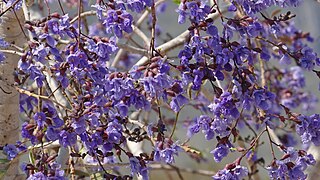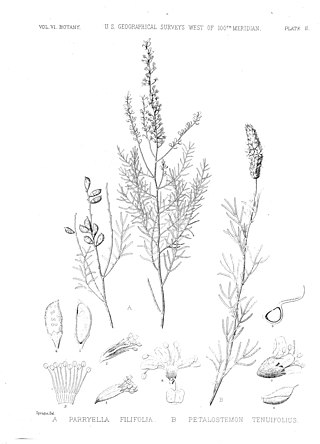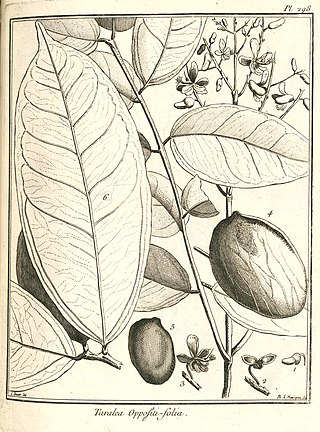
Xanthocercis is a tree genus in the family Fabaceae. It includes three species native to sub-Saharan Africa.

Diplotropis is a genus of trees. It includes ten species native to northern South America, ranging from Colombia and Venezuela to Bolivia and west-central and southeastern Brazil.

Dipteryx is a genus containing a number of species of large trees and possibly shrubs. It belongs to the "papilionoid" subfamily – Faboideae – of the family Fabaceae. This genus is native to South and Central America and the Caribbean. Formerly, the related genus Taralea was included in Dipteryx.
Alexa is a genus of flowering plants. It includes ten species which are native to Venezuela, Guyana, Suriname, French Guiana, and northern Brazil in northern South America. Members of this genus accumulate iminosugars in their leaves.
Angylocalyx is a genus of flowering plants in the family Fabaceae. It includes seven species native to sub-Saharan Africa, ranging from Guinea to Angola, Tanzania, and Kenya.

Chapmannia is a genus of flowering plants in the family Fabaceae. It contains seven species with a scattered distribution – Mexico, Guatemala, Florida, and Venezuela in the Americas, and Somalia and Socotra in eastern Africa. The genus was recently assigned to the informal monophyletic Pterocarpus clade of the Dalbergieae.

Myrocarpus is a genus of flowering plants in the family Fabaceae. It includes five species of trees native to tropical South America, ranging from Venezuela to northern Argentina. Typical habitats include wet to seasonally-dry tropical lowland forest and woodland.

Isotropis is a genus of flowering plants in the family Fabaceae. The genus is endemic to Australia.

Bowdichia is a genus of flowering plants in the legume family, Fabaceae. It belongs to the subfamily Faboideae. The genus includes two species native to tropical South America and Costa Rica.
Candolleodendron brachystachyum is a species of flowering plant in the legume family, Fabaceae. It belongs to the subfamily Faboideae. It is the only member of the genus Candolleodendron. It is a tree native to the Amazon rain forest of northern Brazil (Pará), Suriname, and French Guiana.

Cranocarpus is a genus of flowering plants in the legume family, Fabaceae. It includes three species native to northern and eastern Brazil. It belongs to subfamily Faboideae, and was recently assigned to the informal monophyletic Pterocarpus clade of the Dalbergieae.
Pterocarpus dubius is a species of flowering plant in the family Fabaceae native to Venezuela, Guyana, and northern Brazil in northern South America.
Fiebrigiella gracilis is a species of flowering plants in the legume family, Fabaceae. It is the only member of the genus Fiebrigiella. It belongs to the subfamily Faboideae, and was recently assigned to the informal monophyletic Pterocarpus clade of the Dalbergieae. It is a subshrub native to Ecuador, Peru, and Bolivia.
Fissicalyx fendleri is a species of flowering plant in the legume family, Fabaceae. It is a tree native to the tropical Americas, ranging from Panama through Colombia, Venezuela, and Guyana to northern Brazil. It grows in humid lowland forest.
Panurea longifolia is a species of flowering plants in the legume family, Fabaceae. It belongs to the subfamily Faboideae. It is the only member of the genus Panurea.

Parryella filifolia, the common dunebroom, is a species of flowering plants in the family Fabaceae. It belongs to the subfamily Faboideae. It is the only member of the genus Parryella. It is native to Arizona, Colorado and New Mexico.
Petaladenium urceoliferum is a species of flowering plant in the family Fabaceae. It belongs to the subfamily Faboideae. It is the only member of the genus Petaladenium. It produces three chemical compounds in its leaves that are not found in other members of the Amburaneae: (2S,4S,5R)-5-hydroxy-4-methoxypipecolic acid, (2S,4R,5S)-5-hydroxy-4-methoxypipecolic acid, and (2S,4R,5R)-4-hydroxy-5-methoxypipecolic acid. Petaladenium urceoliferum is unique among legumes in having fimbriate–glandular wing petals.
Sweetia fruticosa is a species of flowering plants in the legume family, Fabaceae and is the only member of the genus Sweetia. It belongs to the subfamily Faboideae. It was traditionally assigned to the tribe Sophoreae, mainly on the basis of flower morphology; recent molecular phylogenetic analyses assigned Sweetia fruticosa into an informal, monophyletic clade called the "vataireoids".

Taralea is a genus of flowering plants in the family Fabaceae. It belongs to the subfamily Faboideae.

Pterodon is a genus of flowering plants in the family Fabaceae. It belongs to the subfamily Faboideae.










